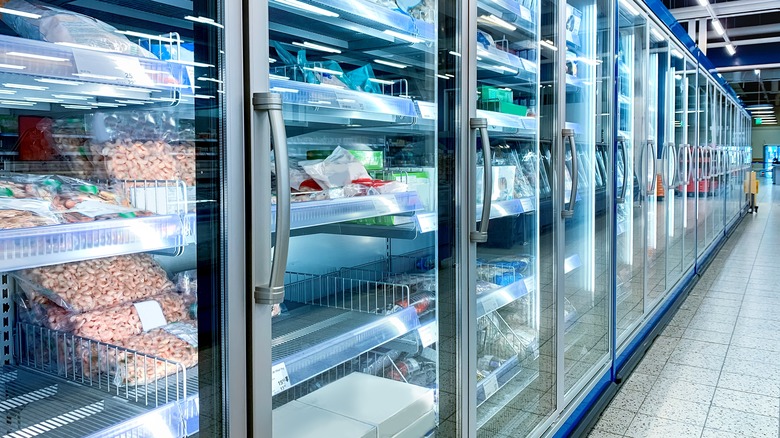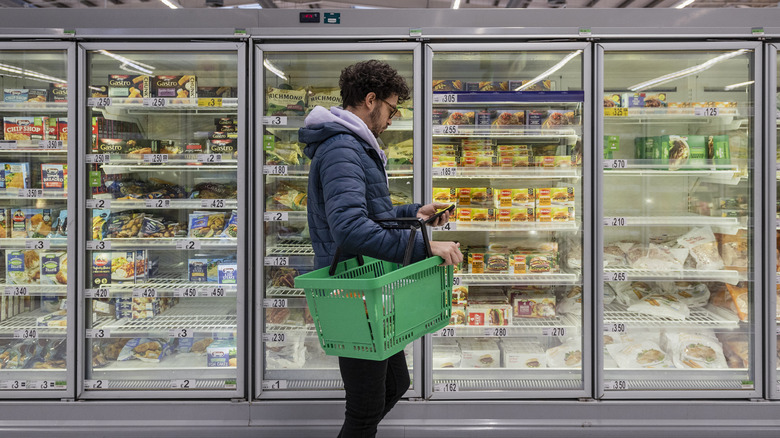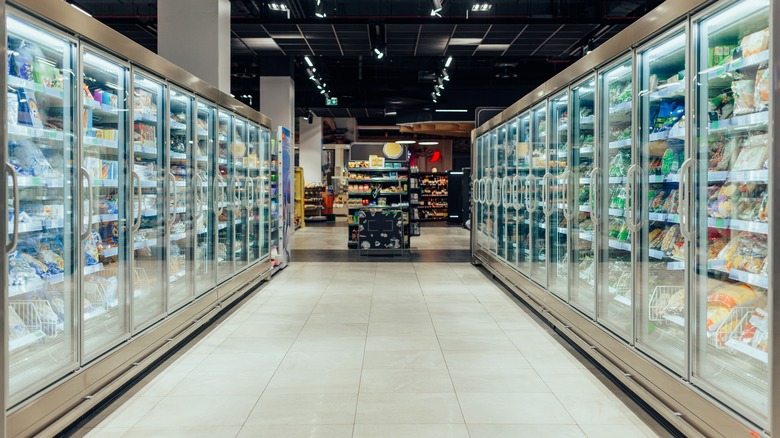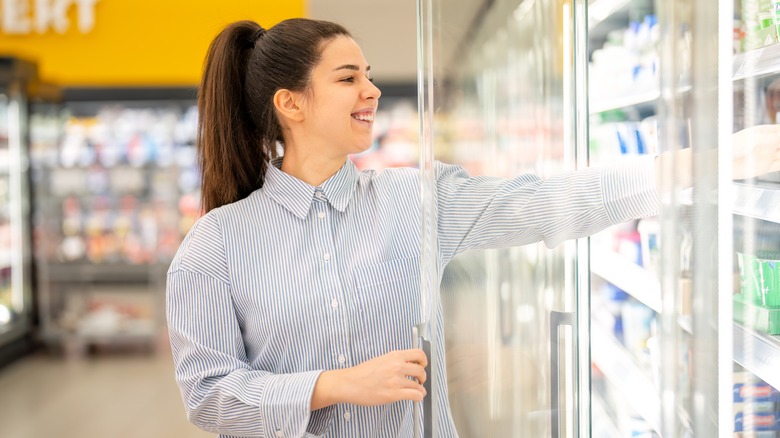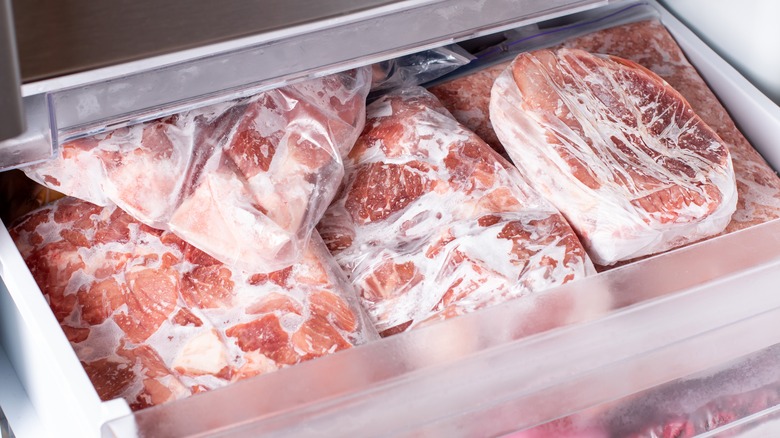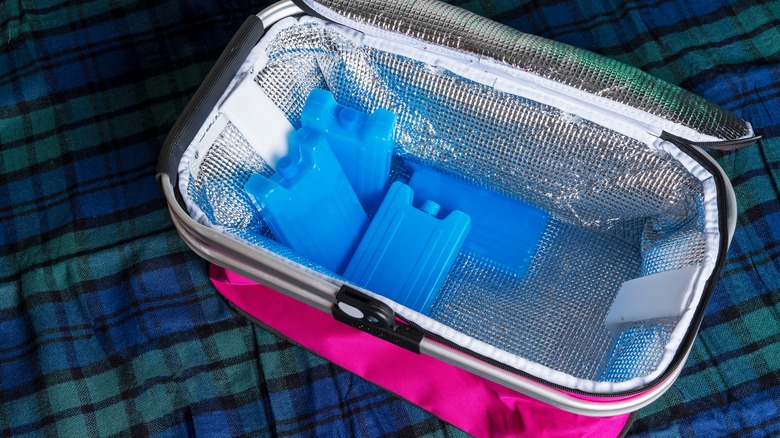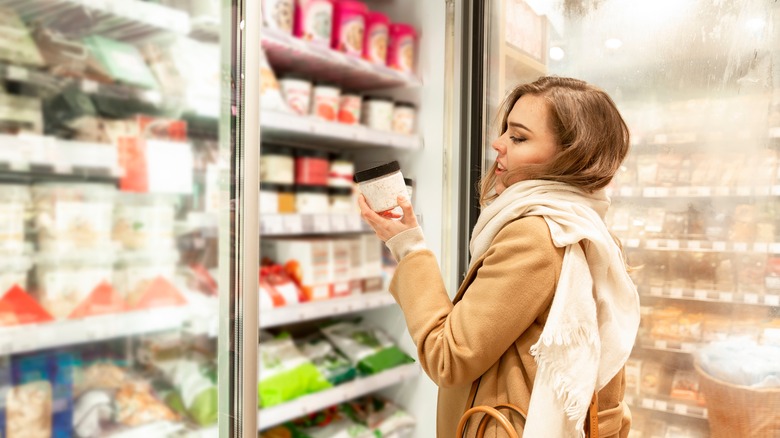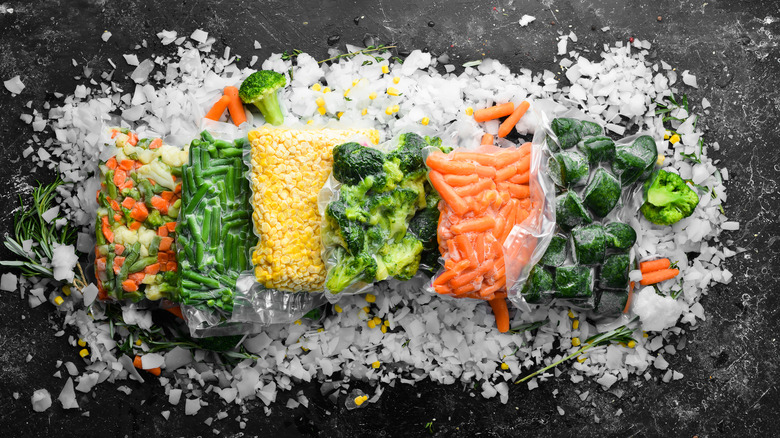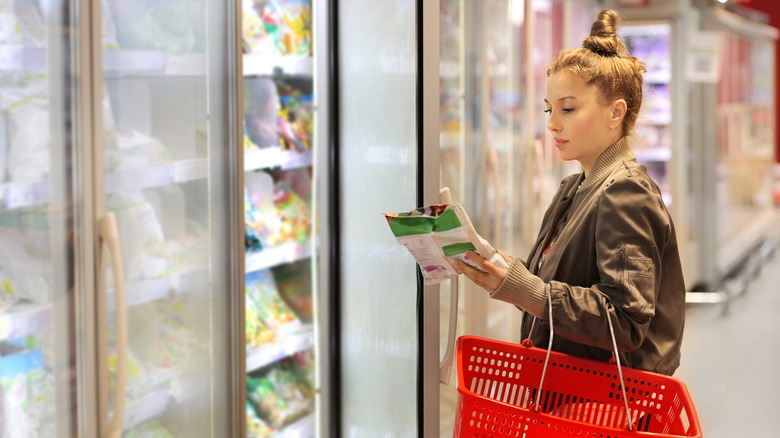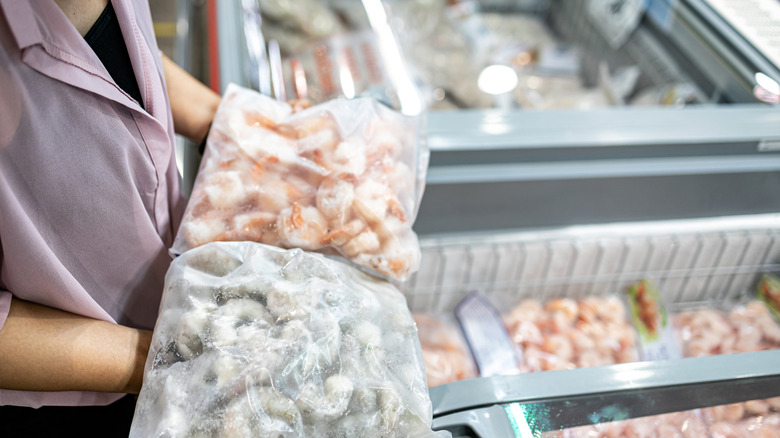9 Mistakes To Avoid In The Freezer Aisle
Visiting the freezer aisle is an essential part of most people's shopping trips. Almost 40% of all people who buy frozen food consume it daily or several times weekly (per The Food Industry Association), which means frozen items are perpetually in high demand. But buying these frozen items can be kind of an obstacle course. Moreover, while these food products are designed to be consumer-friendly, certain mistakes made when buying them can make them more trouble than they're worth.
Because frozen foods are naturally much colder than the wares offered in other parts of the store, how shoppers transport them home can lead to many problems. Icy chicken nuggets, blueberries, and waffles can defrost far more quickly than we'd like, leading to serious issues down the line. The value for money that the freezer aisle offers can also present problems. Everyone likes to stock up at a thrifty price, after all — but while buying food in bulk may save money, it may not be as good of an idea as you think. Moreover, overstocking frozen foods can quickly lead to wastage. There's no need to fear those freezers, though: All you need to do is avoid these nine classic mistakes when you're in the freezer aisle.
1. Buying food you don't have space for
Visiting the freezer aisle is a fantastic opportunity to stock up on cheaper frozen versions of your favorite items. Buying two pounds of wild caught skin-on salmon fillets at Walmart, for example, is significantly cheaper than buying the same weight of fresh salmon. Plus, frozen food lasts way longer in your freezer than in your fridge. No downside, right? Wrong. Spying these deals can lead to a common mishap: You buy them, then you get home and realize your freezer is already crammed full of food, leaving no space for your fresh purchases. In the worst-case scenario, this can result in you having to throw a load of items away, wasting your money egregiously.
The best way to avoid this is by keeping a close eye on your freezer's stock levels. Before you leave the house to go to the store, check your freezer and assess how much space you have for new items. If it's full, consider whether you can use some of the items inside in an upcoming meal to free up space. It's also helpful to practice the "first in, first out" method, where you regularly rotate your older food items to the front of your freezer to use them up and place newer items at the back, to save yourself from clogging up the appliance. This maximizes your freezer space while minimizing effort.
2. Visiting the aisle at the start of your shopping trip
The people who design supermarkets put a lot of thought into the trips customers take there. Each decision about a store's layout, product placements, and even music has been carefully considered to make your experience as easy as possible (and therefore help you buy more stuff). The typical placement of the freezer aisle at the back of the store reflects this thoughtfulness. The thinking is that you head there at the end of your shopping trip, then go straight to the cashier, keeping your items cold for as long as possible.
Don't be tempted to flip this on its head: Heading to the freezer aisle first, or even at the midpoint of your trip, can result in having frozen food in the basket for far longer than is advisable, exposing it to the ambient temperature of the supermarket and causing it to thaw. Remember that it's not just the walk around the store you have to consider, either — your food will continue to warm up on the trip home. Go to the freezer aisle last, as the store designers intended. If you're worried about forgetting what you need mid-shopping trip, write yourself a note and revisit it when you arrive. Remember to pack your shopping with the frozen items on top, or in a separate bag. This way, when you get back home, they can get into your freezer first.
3. Holding the doors open for too long
Deciding what you want from the freezer aisle can take a while, especially if you don't have a set shopping list or you're debating between a few popular frozen dinners. However, there's a reason why these shops' freezer doors are made with transparent glass: Holding them open for too long can greatly deteriorate the stock inside and cause a ramp-up in energy that the environment won't thank you for.
When you open a freezer door, the cold air inside rushes out, causing an overall rise in the inside temperature. This temperature is increased further by the influx of warm air from the outside. When this happens, the freezer then kicks into high gear, expelling more cold air to try and rebalance the situation. All of this takes electricity — and while you may not be footing the bill for your local supermarket's refrigeration units (which take up the majority of a store's bill), all of that energy can have an environmental impact over time, which you may be unknowingly contributing to.
It isn't very kind to your fellow customers, either. The more warm air gets into a freezer, the more likely the products inside are to begin thawing. The person shopping after you will end up with a warmer item that might be outright mushy by the time they get it home. It's far better to resist opening the freezer door until you're totally sure of what you want.
4. Bulk-buying freezer food you don't eat very often
A freezer can be a real treasure trove of foods, and an especially useful place to store those less-common items you still want to hand, like frozen Jiaozi dumplings or unique popsicles. Buying these items in bulk and then forgetting to eat them, though, can lead to serious degradation. Food can continue to lose quality in the freezer, and while this happens at a slower rate than it would at room temperature or in the fridge, tastes and textures can significantly change. This can happen even more quickly when your items are packaged incorrectly, which may cause freezer burn.
You should always aim to eat your freezer food within the time designated on its packaging, or within its general freezer lifespan. Some meats, like lamb, pork, and chicken, may only remain fresh for a few months in the freezer, and only if they've been wrapped up properly. It's also a good idea to try not to cram in all your bulk-bought food, even if you're planning on eating it quickly. Doing so can disrupt the airflow in your freezer and prevent it from staying at the right temperature consistently. This may, in turn, make your food deteriorate quickly.
5. Forgetting to bring your cooler bag
Transporting frozen items from the freezer aisle to your kitchen can be tricky, especially on a hot day. Heat in cars can reach scorching levels, and even if you have your air conditioning switched on when driving to the store, leaving your car stationary for just 10 minutes can cause its internal temperature to rise by up to 20 degrees Fahrenheit. If you have a particularly long drive home — and sometimes even if you have a short one — your frozen items thaw rapidly, leaving you with a choice. Do you refreeze them and risk diminishing their quality, or throw them out?
Bringing a cooler bag and packing your frozen goods inside it can help you avoid this. These bags insulate your frozen items and protect them from heat on the outside. You can increase their effect by packing them with ice packs, which will reduce the interior temperature and keep your food nice and cold. As an added layer of protection, it's often a good idea to put your frozen goods on a seat in your air-conditioned car instead of in the trunk, where they're more likely to overheat.
6. Grabbing food from the top of the pile
Although it can be a bit annoying to try to grab your frozen items from the very back of the freezer unit, doing so can help you get the best product possible. Freezers, and the food within them, tend to be colder at the back, due to its lesser chance of contact with the warm air that rushes in from the outside as the door opens. (The bottom of the freezer tends to be coolest too, since cold air sinks.) Conversely, the food at the top and front of the pile regularly comes into contact with warm air. If that food has been there for a while and is repeatedly being warmed up and cooled down, it can develop ice crystals, which may alter its flavor or quality.
Food at the top of the pile also has a higher chance of having been picked up and examined by other customers, increasing the chance of its packaging being bent or damaged, or streaked with grubby fingerprints and germs. Food at the bottom, meanwhile, will likely have had less contact with other people's hands. Just make sure that you double-check the sell-by date of any food you unearth from the bottom of the freezer, especially if you're in a smaller store that might not rotate stock as frequently. You don't want to accidentally go home with an expired product.
7. Picking up food that's covered in ice
It's natural to assume frozen food covered in ice is a safe bet. After all, ice keeps the food cold — surely this will help preserve it for longer, right? Not quite. The presence of ice in a freezer aisle, both on your food and in the freezer itself, can indicate that it's raised and dropped in temperature repeatedly, causing the moisture inside to evaporate and re-solidify as crystals.
On food, this can indicate that it's freezer burned, or on its way to being so. Warm air in a freezer can cause a food's natural moisture to escape, with subsequent cold air then freezing it on its surface. When this happens, the food starts to dehydrate. This can result in food items not just losing moisture, but having their flavor and consistency changed. This may be more likely to happen with less-popular items that aren't restocked as frequently, as they have more time to build up ice crystals before being bought, as well as foods with higher water content. Freezer-burnt food isn't unsafe, but let's be real — if you're spending money on it, you want the best product possible.
8. Putting your freezer food back after walking around the store
We've all changed our minds about items we want when in the supermarket. It's natural to want to return that enticing new pie from a new frozen pizza brand when you start having second thoughts about taking a chance on an unknown vendor. But when it's freezer food, doing so can be tricky. Depending on how long you've been in the store and how long your food's been in your cart, you may be putting back an item that's already semi-thawed.
When this happens, you either leave someone else to pick up the degraded item or force the store to throw it out. This can eat into their profits, and if you're in a family-run store, this may not be an insignificant loss. Prompting the store to throw it out also contributes to food wastage. Almost a third of all grocery store food is already thrown away, adding up to 16 billion pounds yearly (per RTS), which means it's important to reduce excess refuse instead of making more of it.
No one's saying that you should simply buy that item you don't want anymore, though. Just hand it over to a store attendant, instead of putting it back yourself. They can then assess whether it's okay to put it back on the shelf, or whether it can potentially be sold at a reduced price.
9. Failing to check whether the packaging's intact
If you're spending money in a supermarket, the last thing you want to do is come home with a load of unsightly damaged items. But in the freezer aisle, this damage can be more than cosmetic. Ripped, opened, or otherwise damaged frozen food packaging can expose the food to the freezer's cold air, which causes it to dehydrate and develop freezer burn. More worryingly (but thankfully more rarely), broken or damaged packaging can indicate that the food inside has been tampered with.
As such, if any packaging isn't intact, leave the item where it is and alert the store manager or a member of staff. Sometimes, this damage can be pretty subtle: A frozen food box may have been opened, peeked into, and closed again, and all that gives it away is a slightly bent seal or loose cardboard. Make sure you check your items carefully before you put them in your cart.
There are situations where slightly damaged packaging may not be the worst thing in the world. A slightly crumpled box that has a plastic-encased item inside may look damaged, but as the food has been protected from cold air by plastic wrap, it might still be good to eat. You may even be able to get a few bucks knocked off the price for this damage.
